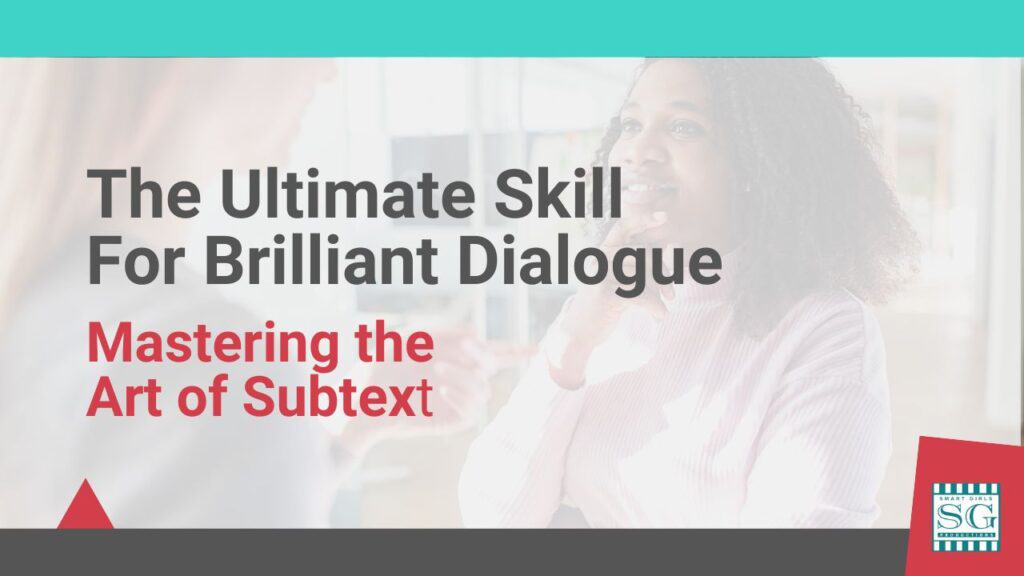Let’s chat about subtext in screenwriting, shall we?
I hope you said “By all means, yes!” because it is truly a game-changer for your screenplay when you master the art of writing subtext into your dialogue.
I decided to write this article because I’ve been critiquing a lot of screenplays lately where the dialogue is falling short around dialogue in particular. The fact is that you must understand the art of subtext if you want your screenplay to be great.
Subtext is an understated but key ingredient of dialogue that makes your characters interesting to watch and, in fact, even in real life makes people much more interesting.
Flirtation or banter between two characters is always far more interesting when they “imply” things without directly saying it. And I could give you some really great examples of that… if you know what I mean, haha, but I am going to let your imagination run wild thinking of what examples I might mean!
SEE? I just did it there. I implied something without saying it directly, and hopefully your imagination got engaged. That’s what subtext is, even though mine was intentionally a bit corny. But the point is, something was implied without saying it. The technique is used greatly in comedy, but it certainly is used in drama as well so we must know it well.
Writing with subtext will take your dialogue to a whole new level and will engage your audience much more greatly than writing the dreaded, boring “on-the-nose” style of dialogue.
When you use subtext, a viewer essentially becomes a mini-detective trying to figure out what the subtext of a given character really means. With subtext, you’re pretty sure what they mean and what they are implying… but only time will tell if you’re right! Subtext engages the imagination and makes you want to keep watching to find out.
Given that subtext in screenplays can be so powerful, now we’re going to take a deeper dive into this awesome world of crafting your dialogue so you can be more equipped to use this skill in your writing.
We’re first going to explore a bit more about why it’s so crucial then we’ll take a look at some examples and how you can nail it so it has the desired impact on your story.
What Exactly Is Subtext?
Subtext is all about what’s not being said. It reflects the deeper thoughts and feelings your characters want to express OR could be trying to hide – but they’re not directly saying what’s on their mind.
It makes your characters and the dynamics of their relationship richer and more complex. It turns a simple conversation into a captivating game of “What’s really going on here?”
By not spelling everything out, you’re inviting your audience to lean in, to pay attention, and get involved with your characters. Sometimes basic dialogue is appropriate, of course, but in the meatier scenes, subtext becomes like an underground river where we can sense what your characters are truly thinking, feeling, and wishing for, without them having to spell it out. Subtext means that there is something implied… but unsaid.
Techniques to Incorporate Subtext
Now that we know the nature and significance of Subtext, let’s look at a few techniques for actually incoporating Subtext into Your Dialogue and your characters.
As you go through the following examples, a good trick to help your understanding is to think about a time when you have either said something like these things OR someone said them to you!
Here we go, a few ways to incorporate subtext:
Irony or Sarcasm – Subtext often has irony or sarcasm. With this a character says one thing but means another. It’s all in the way they say it. This is so important that actors are taught about subtext in their classes so they can bring that to their characters as well. Of course, it’s a lot easier for them if it’s already built into the story, plus, you are more likely to have the character be interpreted the way you want them to if you build the subtext in!
Double Entendre – This is where you can get a little sneaky and fun with the dialogue and its hidden layer. The double entendre is especially important in any romantic banter, where the dialogue is such that it could be taken two ways.
Conflict and Contradiction – Sometimes a character (just like a person) is just a big mess of contradictions. They say one thing adamantly – but somehow you know that deep down they feel the exact opposite. They’re like a tornado of different feelings all mixed together. That’s what makes them gripping to watch. You’re waiting for the clarity to come. In movies, that clarity usually comes by the end of the film! But in life? Well… maybe or maybe not! That is why it’s important to get it in the movies!
Symbolism – You can use symbolism to drop hints about what’s brewing beneath the surface. It’s like leaving breadcrumbs for your audience to follow. Essentially we’re talking about foreshadowing something. When we see those ominous clouds brewing in the sky as we cut away from a dramatic scene… that’s definitely a symbol and it’s foreshadowing something.
Nonverbal Cues – Although subtext is typically found in dialogue, it can also be found in other elements of the story. As we know, actions speak much louder than words. A character who unexpectedly pulls away from a kiss with a guilty look on her face who then pretends all is fine… says far more than a monologue would… and is a lot more interesting to watch.
Let’s look at some specific examples.
Examples of Subtext
Here are some examples from well-known films where the subtext adds depth to the characters and their interactions:
“The Godfather” (1972) – Michael Corleone’s dialogue:
Michael’s Dialogue: “It’s not personal, Sonny. It’s strictly business.”
The Subtext: On the surface, Michael is rationalizing a violent act as a business decision. However, the subtext reveals his transformation from a family outsider to someone deeply entangled in the mafia’s moral ambiguity.
“Casablanca” (1942) – Rick Blaine and Ilsa Lund’s dialogue exchange:
Casablanca is one of my Top 10 favorite movies. This is a very famous dialogue exchange.
Rick’s Dialogue:”Of all the gin joints in all the towns in all the world, she walks into mine.”
Ilsa’s Dialogue: “Play it once, Sam. For old times’ sake.”
The Subtext: These lines are tinged with nostalgia and unspoken emotion. Rick’s line conveys his shock and unresolved feelings for Ilsa, while Ilsa’s request to Sam hints at her lingering love for Rick. But all of that is beneath the surface and it evokes so much emotion in the viewer/reader!
“Jaws” (1975) – Chief Brody:
Chief Brody’s Dialogue: “You’re gonna need a bigger boat.”
While this line is a literal observation about the inadequacy of their boat against the shark, it also subtly underscores the characters’ underestimation of the situation and the looming threat they face. It also has sheer entertainment value because of the double entendre and wittiness of it!
Gone with the Wind” (1939) – Rhett Butler:
Rhett’s Dialogue: “Frankly, my dear, I don’t give a damn.”
The Subtext: This iconic line, on the surface, shows Rhett’s indifference. However, it’s also a moment of revelation and resignation, marking the end of his tumultuous relationship with Scarlett and his own transformation. It implies both a sadness that it didn’t work out and a final resignation that it’s over.
“Forrest Gump” (1994) – Forrest Gump:
Forrest’s Dialogue: “My momma always said life was like a box of chocolates. You never know what you’re gonna get.”
The Subtext: This line is a simple metaphor for the unpredictability of life. It shows Forrest’s optimistic outlook on life’s unpredictable nature while at the same time accepting that it can be random and sometimes challenging.
Melody Jackson was named one of the Top Script Analysts Three Times out of three in different blind surveys conducted by Creative Screenwriting over an 11-year period, receiving especially high marks on on value for the price and depth of analysis. Melody has a Ph.D. in Mythological Studies and has critiqued thousands of screenplays in depth, working with all levels of screenwriters from new to produced established writers. Click to learn more about Script Analysis by Melody.
Impact of Subtext on Your Story
You can see that these famous lines of dialogue that have been repeated countless times can be layered with meaning and add depth and nuance to characters and the narrative. As you can see, subtext invites audiences to look beyond what is being said, engaging them more deeply with the story and its themes.
Subtext makes screenwriting deliciously complex. When you are able to write a scene with strong subtext, it’s very much like adding depth and shading to a painting – it makes everything more vivid and real and juicy.
Subtext helps turn your screenplay into an interactive experience where the audience gets to dig deep and feel it all. It also ramps up the suspense and keeps them guessing and piecing things together, which in turn keeps them reading the screenplay or glued to their seats watching the movie
Summary
In short, subtext can help you turn a good screenplay into an unforgettable one. It’s all about letting your characters’ unspoken truths bubble away under the surface, creating a delicious feast of layers and emotions, while the audience watches and tries to understand.
To develop your mastery in this skill, next time you sit down to write, think about the power of what’s not said. Instead of having your characters spill it all out, have them hold back or say things in other ways. Look at the examples above as well as the literary devices to see how you can utilize them.
Mastering the art of subtext will immediately and greatly elevate the quality of your screenplay and put some points on the board for you toward selling your screenplay and seeing it made into a movie. Here’s wishing you all the best, kid!
(Oh, yeah, that’s another literary device… referencing something from the past.)


